Comments / Questions (116)
![]() Francoise wrote:
Francoise wrote:
Comment fait on pour avoir une version francaise. Merci à vous.
31.08.2019 - 10:51DROPS Design answered:
Bonjour Françoise, cliquez sur le menu déroulant sous la photo et choisissez "français". Bon tricot!
02.09.2019 - 09:26
![]() Line wrote:
Line wrote:
J'apprécie énormement et j'adore votre site pour le modèle numéro 112-40 quelles longueur d'aiguilles circulaires me conseillez vous pour la bordure afin de relever les 375 mailles don't j'ai besoin Merci et au plaisir Line
23.08.2019 - 21:43DROPS Design answered:
Bonjour Line, si vous n'avez qu'une 80 cm, elle devrait faire l'affaire, si vous en avez une plus longue, vous pouvez l'utiliser. Bon tricot!
26.08.2019 - 08:34
![]() Line wrote:
Line wrote:
Bonjour, au moment des diminutions de l'emmanchure, pour le small dois-je tricoter le rang sans diminution (0 fois 2 mailles ) donc 2 rangs ou sauter cette étape et poursuivre avec (1 fois 1 diminution) sur 2 rangs ? Merci
03.08.2019 - 19:13
![]() Line wrote:
Line wrote:
Bonjour, au moment des diminutions de l'emmanchure, pour le small dois-je tricoter le rang sans diminution (0 fois 2 mailles ) donc 2 rangs ou sauter cette étape et poursuivre avec (1 fois 1 diminution) sur 2 rangs ? Merci
03.08.2019 - 18:55DROPS Design answered:
Bonjour Line. Pour la taille S, vous sautez l’indication 0 fois 2 mailles et poursuivez avec 1 fois 1 diminution. Bon tricot!
03.08.2019 - 19:22
![]() Schuebeler-trippel wrote:
Schuebeler-trippel wrote:
Ich habe mir eine Jacke gestrickt.Kann nur nicht die Blende schricken.
26.02.2019 - 10:20
![]() Ellen wrote:
Ellen wrote:
Hei! Har tenkt å strikke denne Big Merino. Kva pinnestørrelde må eg bruke få? Og må egge ned ein størrelse?
18.01.2019 - 20:00DROPS Design answered:
Hei Ellen. Det som avgjør hvilke garn du bytte ut det oppgitte garnet med er strikkefastheten. Denne jakken har en strikkefasthet på 21 m x 42 p rillestrikk = 10 x 10 cm, og er derfor strikket i garn fra garngruppe B. Big Merino tilhører garngruppe C og har derfor en annen strikkefasthet. Det vil bli vanskelig å bytte til Big Merino, da dette garnet nok er for tykt uansett hvilke pinner du bruker. Du kan selvfølgelig lage en prøvelapp å se om du får den angitte strikkefastheten. Om du strikker med feil strikkefasthet vil målene på plagget bli annerledes enn angitt. God fornøyelse
21.01.2019 - 10:13
![]() Ellen wrote:
Ellen wrote:
Hei! Har tenkt å strikke denne Big Merino. Kva pinnestørrelde må eg bruke få? Og må egge ned ein størrelse?
18.01.2019 - 17:34Mariella wrote:
Hello, I have a question on the size of the shoulders. On the pattern I see cm 38 but when I compare it to the stitches (80) after binding off for the armhole and before binding off the neckline, I get 28 cm (80 stc at 28 stc per 10 cm) instead of 38. What is correct? Thank you!
04.11.2018 - 10:45DROPS Design answered:
Dear Mariella, These 38 cm are matching the 80 sts you have after binding off the sts for armhole in size M - with a tension of 21 sts = 10 cm in garter st, these 80 sts = 38 cm - the 28 sts = 10 cm are worked in rib. Happy knitting!
05.11.2018 - 09:28Mariella wrote:
Hello, I have a question on the size of the shoulders. On the pattern I see cm 38 but when I compare it to the stitches (80) after binding off for the armhole and before binding off the neckline, I get 28 cm (80 stc at 28 stc per 10 cm) instead of 38. What is correct? Thank you!
04.11.2018 - 10:43Stephanie Dukes wrote:
Right front piece says cast on 101 stitches for largest size but with one edge stitch each side that leaves an uneven number of stitches for the K1p1 ribbing. Is the stitch count correct?
20.05.2018 - 23:06DROPS Design answered:
Hi Stephanie, As you say you have 1 edge stitch at the side and 1 edge stitch towards mid front. When working rib you start and end with K1, so it doesn't matter that the number of stitches in uneven. Happy knitting!
22.05.2018 - 07:53
Jamie#jamiecardigan |
|
|
|
|
Knitted DROPS Jacket with rib in ”Merino Extra Fine”. Size S - XXXL.
DROPS 112-40 |
|
|
GARTER ST (back and forth on needle): K all rows. BUTTONHOLES: Make buttonholes on right front band. 1 buttonhole: K2 tog and cast on 1 new st on return row. Make buttonholes when piece measures 12, 20 and 28 cm / 4¾", 8" and 11", measured from bottom edge, for all sizes. --------------------------------------------------------- BACK PIECE: Worked back and forth on needle. Cast on 130-142-154-168-184-200 sts (includes 1 edge st each side) on needle size 4 mm / US 6 with Merino. P 1 row from WS and continue in rib, K1-P1, with 1 edge st each side in garter st. REMEMBER THE KNITTING GAUGE. When piece measures 5 cm / 2" dec 1 st each side on every 3 cm / 1⅛" a total of 8 times = 114-126-138-152-168-184 sts. When piece measures 28 cm / 11" continue in garter st – see above. AT THE SAME TIME on first row dec 28-32-34-36-42-46 sts evenly = 86-94-104-116-126-138 sts. When piece measures 40-41-42-43-44-45 cm / 15¾"-16⅛"-16½"-17"-17¼"-17¾" bind off for armhole each side at the beg of every row: 3 sts 1 time, 2 sts 0-1-3-4-6-8 times and 1 st 1-2-2-5-5-6 times = 78-80-82-84-86-88 sts. When piece measures 58-60-62-64-66-68 cm / 22¾"-23⅝"-24⅜"-25¼"-26"-26¾" bind off the middle 16-18-20-22-24-26 sts for neck and complete each shoulder separately. Bind off 1 st on neckline on next row = 30-30-30-30-30-30 sts left on shoulder. Bind off when piece measures 60-62-64-66-68-70 cm / 23⅝"-24⅜"-25¼"-26"-26¾"-27½". RIGHT FRONT PIECE: Cast on 66-72-78-85-93-101 sts (includes 1 edge st at the side and 1 edge st towards mid front) on needle size 4 mm / US 6 with Merino. P 1 row from WS and continue in rib, K1/P1, with 1 edge st each side in garter st. When piece measures 5 cm / 2" dec at the side as described for back piece = 58-64-70-77-85-93 sts. When piece measures 28 cm / 11" continue in garter st, AT THE SAME TIME dec 14-16-17-18-21-23 sts evenly on first row = 44-48-53-59-64-70 sts. When piece measures 35-36-37-38-39-40 cm / 13¾"-14¼"-14½"-15"-15¼"-15¾" bind off to shape the neckline at the beg of row from mid front: 1 st on every 2 cm / ¾" a total of 9-10-11-12-13-14 times. AT THE SAME TIME when piece measures 40-41-42-43-44-45 cm / 15¾"-16⅛"-16½"-17"-17¼"-17¾" bind off for armhole at the side as described for back piece. When all dec are complete there are 31-31-31-31-31-31 sts left on shoulder (incl 1 edge st towards mid front). Bind off when piece measures 60-62-64-66-68-70 cm / 23⅝"-24⅜"-25¼"-26"-26¾"-27½". LEFT FRONT PIECE: Like right front piece, but mirrored. SLEEVE: Worked back and forth on needle. Cast on 66-70-72-74-78-80 sts (includes 1 edge st each side) on needle size 4 mm / US 6 with Merino. Work rib, K1/P1, with 1 edge st each side. When piece measures 8 cm / 3⅛" continue in garter st, AT THE SAME TIME dec 16-18-18-18-20-20 sts evenly on first row = 50-52-54-56-58-60 sts. Now inc 1 st each side, and repeat the inc on every 3.5-2.5-2.5-2-2-1.5 cm / 1¼"-⅞"-⅞"-¾"-¾"-½" a total of 12-14-16-18-19-21 times = 74-80-86-92-96-102 sts. When piece measures 49-48-48-47-46-44 cm / 19¼"-19"-19"-18½"-18"-17¼" – less for the larger sizes because of longer sleeve cap and wider shoulder – bind off for sleeve cap each side at the beg of every row: 3 sts 1 time, 2 sts 4-4-5-5-5-5 times, 1 st 0-1-1-2-5-8 times, then 2 sts each side until piece measures 55-55-56-56-57-57 cm / 21⅝"-21⅝"-22"-22"-22½"-22½", bind off 3 sts each side and bind off remaining sts. Piece measures approx 56-56-57-57-58-58 cm / 22"-22"-22½"-22½"-22¾"-22¾". ASSEMBLY: Sew shoulder seams. Set in sleeves. Sew side and sleeve seams inside 1 edge st. FRONT BANDS: Pick up 375-391-405-421-435-451 sts inside 1 edge st along right front piece, round neckline and down along left front piece. K 1 row from WS and continue as follows: 5 garter sts, rib K1/P1 and finish with K1 and 5 garter sts. When piece measures 3 cm / 1⅛" make BUTTONHOLE on right front band – see above. When piece measures 5 cm / 2" slip 98-101-104-107-110-113 sts each side (= towards bottom edge) on a stitch holder and continue on remaining sts for collar. AT THE SAME TIME slip 6 sts on the stitch holder each side at the end of every row a total of 8-8-8-9-9-9 times = 146-149-152-161-164-167 sts on stitch holder each side. Rib now measures approx 10-10-10-11-11-11 cm / 4"-4"-4"-4⅜"-4⅜"-4⅜" where widest. Slip all sts from stitch holders back on needle and work 1 row rib as before on all sts. Bind off in rib. Sew buttons on left front piece to fit buttonholes. |
|
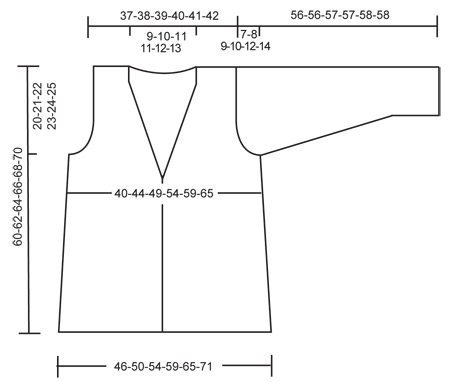 |
|
Have you finished this pattern?Tag your pictures with #dropspattern #jamiecardigan or submit them to the #dropsfan gallery. Do you need help with this pattern?You'll find 17 tutorial videos, a Comments/Questions area and more by visiting the pattern on garnstudio.com. © 1982-2025 DROPS Design A/S. We reserve all rights. This document, including all its sub-sections, has copyrights. Read more about what you can do with our patterns at the bottom of each pattern on our site. |







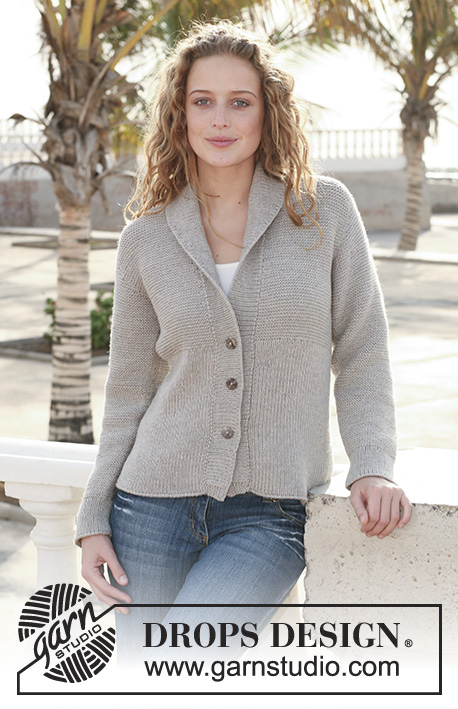
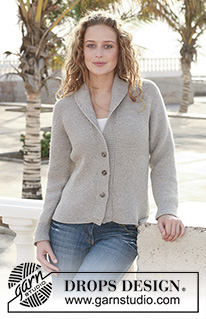


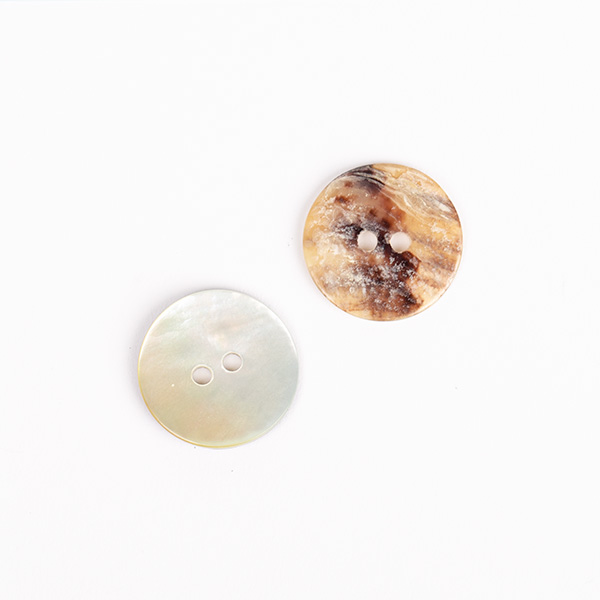

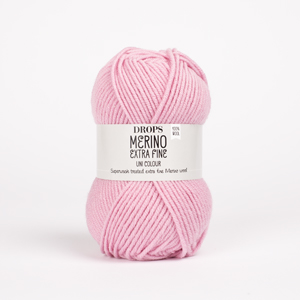
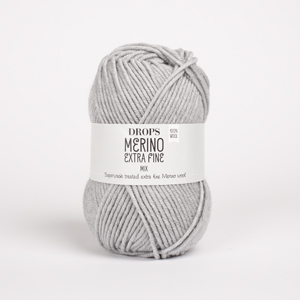


































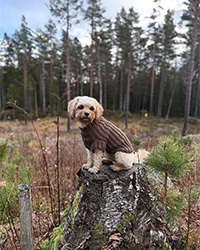
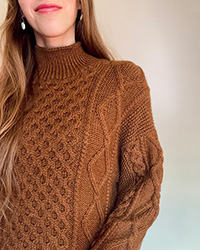
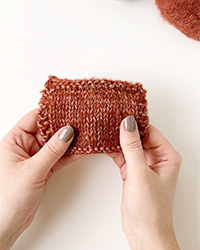
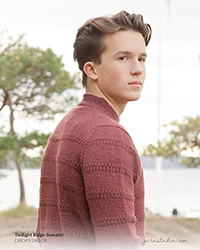
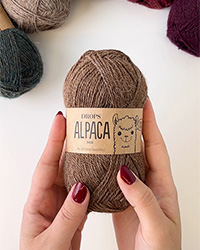
Post a comment to pattern DROPS 112-40
We would love to hear what you have to say about this pattern!
If you want to leave a question, please make sure you select the correct category in the form below, to speed up the answering process. Required fields are marked *.